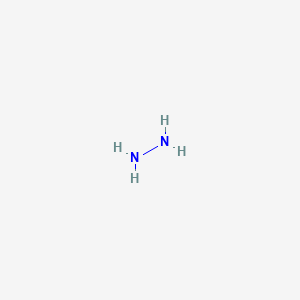| General Information of MET (ID: META00945) |
| Name |
Hydrazine
|
| Synonyms |
Click to Show/Hide Synonyms of This Metabolite
Amerzine; Catalyzed hydrazine; Diamide; Diamine; Diazane; H2NNH2; HDZ; Hydrazin; Hydrazine (anhydrous); Hydrazine (hydrazine sulfate); Hydrazine (hydrazine sulphate); Hydrazine base; Hydrazine dihydrochloride; Hydrazine hydrate; Hydrazine monohydrate; Hydrazine mononitrate; Hydrazine nitrate; Hydrazine phosphate (1:1); Hydrazine phosphate (2:1); Hydrazine solution; Hydrazine sulfate; Hydrazine sulfate (1:1) monosodium salt; Hydrazine sulfate (2:1); Hydrazine tartrate; Hydrazines; Hydrazyna; Levoxine; N2H4; Nitrogen hydride; Oxytreat 35; Scav-ox II; Segidrin; Zerox
|
| Source |
Endogenous;Drug Metabolite;Food;Carcinogenic Potency;Toxins/Pollutant;Cosmetic;Food additives
|
| Structure Type |
Homogeneous other non-metal compounds (Click to Show/Hide the Complete Structure Type Hierarchy)
Homogeneous non-metal compounds
Homogeneous other non-metal compounds
|
| PubChem CID |
|
| HMDB ID |
|
| Formula |
H4N2
|
| Structure |
<iframe style="width: 300px; height: 300px;" frameborder="0" src="https://embed.molview.org/v1/?mode=balls&cid=9321"></iframe>
|
 |
|
3D MOL
|
2D MOL
|
|
Click to Show/Hide the Molecular/Functional Data (External Links/Property/Function) of This Metabolite
|
| KEGG ID |
|
| ChEBI ID |
|
| FooDB ID |
|
| ChemSpider ID |
|
| Physicochemical Properties |
Molecular Weight |
32.046 |
Topological Polar Surface Area |
52 |
| XlogP |
-1.5 |
Complexity |
N.A. |
| Heavy Atom Count |
2 |
Rotatable Bond Count |
N.A. |
| Hydrogen Bond Donor Count |
2 |
Hydrogen Bond Acceptor Count |
2 |
| Function |
Being bifunctional, with two amines, hydrazine is a key building block for the preparation of many heterocyclic compounds via condensation with a range of difunctional electrophiles. With 2,4-pentanedione, it condenses to give the 3,5-dimethylpyrazole. In the Einhorn-Brunner reaction hydrazines react with imides to give triazoles. Hydrazine is a convenient reductant because the by-products are typically nitrogen gas and water. Thus, it is used as an antioxidant, an oxygen scavenger, and a corrosion inhibitor in water boilers and heating systems. It is also used to reduce metal salts and oxides to the pure metals in electroless nickel plating and plutonium extraction from nuclear reactor waste. Hydrazine is an inorganic chemical compound with the formula N2H4. It is a colourless liquid with an ammonia-like odor and is derived from the same industrial chemistry processes that manufacture ammonia. However, hydrazine has physical properties that are more similar to those of water. The propanone azine is an intermediate in the Atofina-PCUK synthesis. Direct alkylation of hydrazines with alkyl halides in the presence of base affords alkyl-substituted hydrazines, but the reaction is typically inefficient due to poor control on level of substitution (same as in ordinary amines). The reduction of hydrazones to hydrazines present a clean way to produce 1,1-dialkylated hydrazines.
|
|
Regulatory Network
|
|
|
|
|
|
|
|
|
 click to show the details of this protein
click to show the details of this protein
 click to show the details of experiment for validating this pair
click to show the details of experiment for validating this pair
 click to show the details of this protein
click to show the details of this protein
 click to show the details of experiment for validating this pair
click to show the details of experiment for validating this pair

